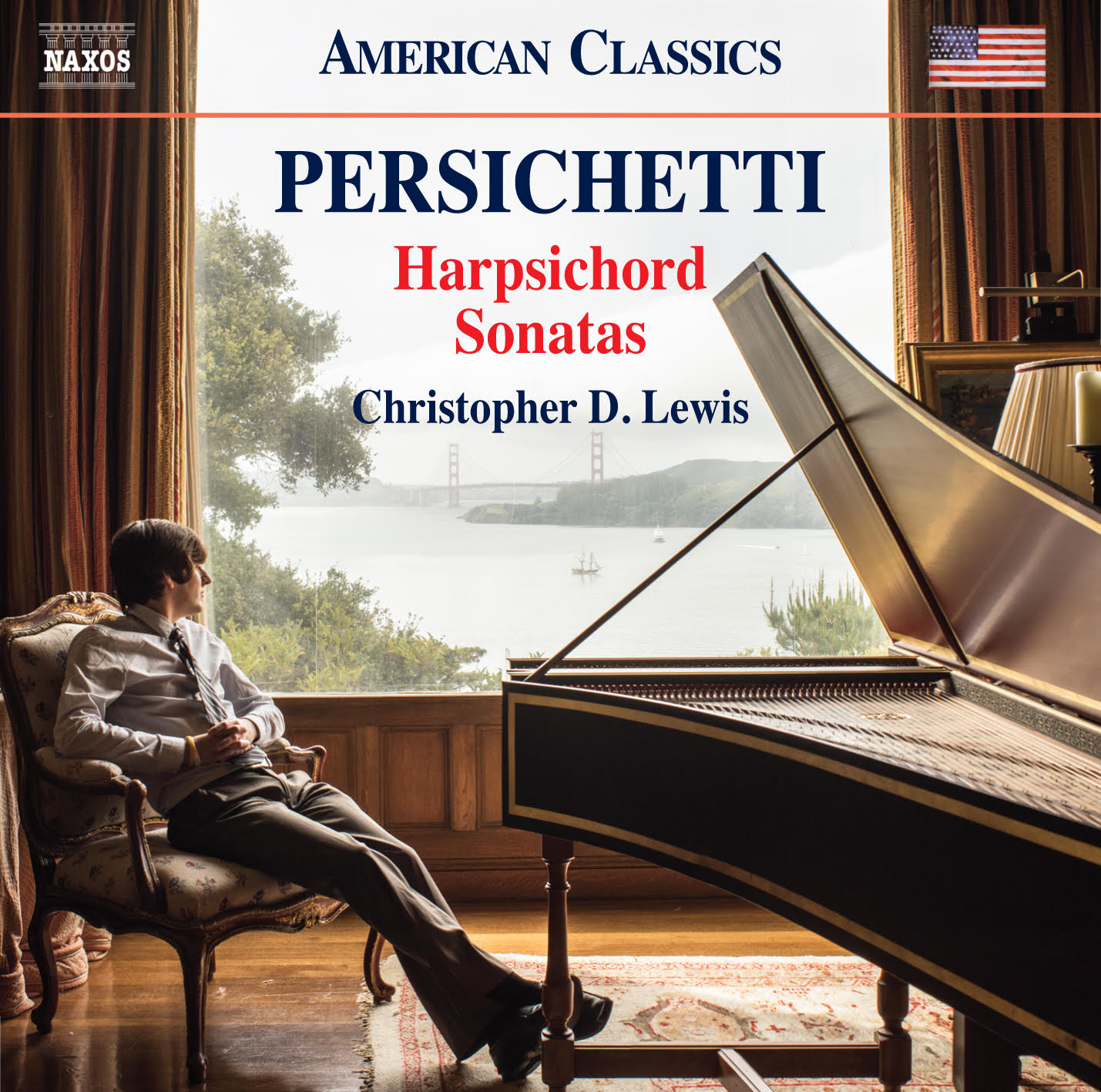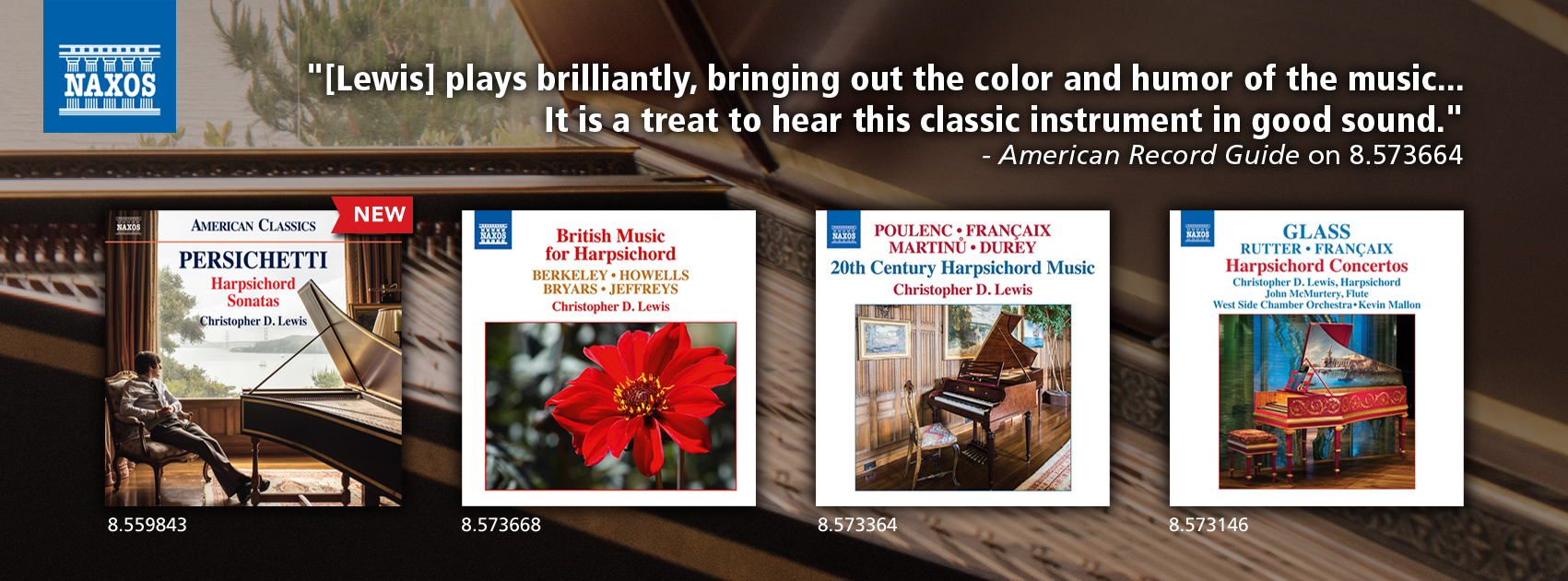Recording the Modern Harpsichord – Persichetti’s Sonatas
PhD researcher Christopher D. Lewis has recently submitted his doctoral thesis AND is about to relase a new recording – double congratulations! Here he introduces us to the harpsichord music of Vincent Persichetti, whose sonatas are the focus of his most recent project:
Christopher D. Lewis (Harpsichord): Vincent Persichetti: Harpsichord Sonatas Nos. 1, 3, 5, 8, 9 and Serenade. Release worldwide 14 July 2017. Naxos Records: https://www.naxos.com/catalogue/item.asp?item_code=8.559843
The American composer Vincent Persichetti (1915-1987) is regretfully not a well-known name outside of serious classical contemporary music circles, but I believe his music deserves to be known by far wider audiences. Persichetti wrote for an amazing array of instruments, but perhaps his compositions for piano and wind band make up his most well-known works. His contribution to the harpsichord is especially prolific and he wrote several solo works for the instrument, including an impressive ten Sonatas. Alongside the likes of British composer Stephen Dodgson, this makes Persichetti one of the composers who contributed most fruitfully to the harpsichord repertoire of the twentieth century.
My own first encounters with Persichetti’s music came weeks into my undergraduate degree at McGill University (Montreal, Canada). All of us first-year music students (about two hundred of us!) were required to sing in the University Chorus and we were presented with a variety of choral music stretching from Bach and Mozart through to contemporary compositions by the likes of Eric Whitacre. In amongst this mélange of music was a composer that I had never encountered before, a certain Vincent Persichetti. We sang his Celebrations for chorus and wind ensemble and I recall being utterly smitten with everything about this work. From the boldness of the harmony, to the sharpness and precision of the articulation – it was all covered by the most remarkable sense and sound of all things ‘American’. As a newcomer to North America, I absolutely adored that and I speedily developed an infatuation with pretty much all of Persichetti’s music (incidentally Celebrations is set to rather innuendo-filled poetry by Walt Whitman, which still makes me smile to this day!).
This is my fourth release for Naxos Records and after three compilation recordings, I was keen to record a disc comprising of a single composer to demonstrate how a composer adapts his or her style of composition to adjust to the ever-changing harpsichord of the twentieth-century. To reflect such changes, I have used two different instruments in this recording. The earlier Sonatas are recorded on a French ‘revival’ harpsichord manufactured by the Parisian piano firm, Pleyel. This kind of revival instrument was popular in the early/mid part of the century and was developed with little attention to the historical design of the harpsichord, but more in an attempt to make an instrument suitable for the modern day. Revival instruments usually had pedals to allow the performer to speedily change what strings are being operated. My recording of the first three Sonatas demonstrates an enormous range of different ‘effects’ using this device, as I wanted to show the musical capabilities of this kind of harpsichord. The latter two Sonatas (and the Serenade) are on a historic copy of a harpsichord (built by the brilliant Californian based Kevin Fryer) reflecting the change in trend of the kind of instrument that was being favoured by performers in the latter part of the century. The striking contrast between the two instruments reflects how the harpsichord developed in the modern era, and demonstrates a trend that moved firmly backwards to the past – as builder Robert Davies astutely noted in 1981: “Is there another trade or profession, I wonder, which evolves so steadily by regressing so assiduously?” (John Paul, Modern Harpsichord Makers, 200.)
Over the past few years I have the most wonderful opportunity to complete a PhD at the University of Southampton focused on the contemporary British harpsichord. This project, which was so generously supported by both the Arts and Humanities Research Council and the National Trust was a dual project with the singer Kate Hawnt and completed under the supervision of Professors Jeanice Brooks and Laurie Stras. For my part of the project I decided to focus on three British composers, Lennox Berkeley, Stephen Dodgson, and Michael Nyman. Moving forward from this project, my next planned disc of recorded music is a collection of works from Hungarian composers (including Bartok, Ligeti and Rózsa), but at some point, I would like to return to Persichetti to record his remaining Sonatas and to complete the recording of all of his harpsichord works. For the moment, I am delighted to have been able to record five of his Sonatas (alongside the short Serenade and to contribute to the growing number of recordings and hopefully awareness and interest of this brilliant and underrated composer. Most importantly I wanted to bring new awareness of his beautifully idiomatically written harpsichord compositions and I hope I have achieved this.
Christopher D. Lewis is a contemporary harpsichordist originally hailing from South Wales. He recently submitted his PhD at the University of Southampton on contemporary British harpsichord music. His discography with Naxos Records, the world’s largest independent classical music label, includes several contemporary harpsichord recordings stretching from Francis Poulenc to Philip Glass. Lewis works as a university lecturer at Southampton Solent University and was recently appointed an Honorary Fellow of the Guild of Musicians alongside Dame Dr Patricia Routledge.



